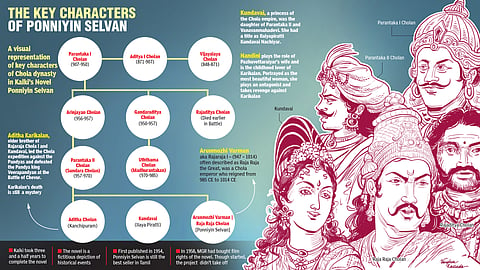

Mani Ratnam, the maestro who is bringing his epic film 'Ponniyin Selvan: I' to the theatres this week, had earlier attempted to adapt Kalki Krishnamurthy's eponymous novel into a film not once, but twice. "I first read this book when I was in college. Almost 40 years have passed. It's not left my heart until now. My first thanks go to Kalki," he said during the film's audio and trailer launch.
The legendary director even said that he was glad this film didn't materialise back then because he feels the present is far more equipped to handle such a subject on screen given the technological advances.
The film's story, a historical fiction that deals with the Chola period, is told in a very adventurous way. Kalki's writing in the novel is very vivid and that shaped Mani Ratnam's vision to tell this story on the big screen.
This Ponniyin Selvan guide is for those who are not familiar with the characters, plot. (And, of course, finishing 2,500 pages just before the movie's release is too scary)
The novel:
The book written by Kalki Krishnamoorthy chronicles the story of the early days of Arunmozhivarman, one of the most powerful kings in the south, who went on to become the great Chola emperor Rajaraja Chola I.
The novel was first serialised in the weekly editions of Kalki from 29 October 1950 to 16 May 1954, and released in book form of five parts in 1955.
The plot:
Ponniyin selvan follows the story of the Chola kingdom and the battle for succession, when current emperor Sundra Chola, who is on the hands of Pazhuvettaraiyars, is bedridden.
When Arulmozhi Varman aka Ponniyin Selvan, is believed by the people to be the right choice for the throne, the Pazhuvettaraiyars, who basically control the affairs of the bedridden king, conspire with other allies for Madurantakan (Sundara Chola brother's son), who is married to their daughter, to take over the throne.
While princess Kundavai also believes that Arulmozhi will become a great emperor, Nandini a major antagonist in the story, seeks to conspire with the Pandyas with the mission to destroy the Cholas.
About the film:
The film based on Kalki Krishnamurthy's novel has its screenplay written by Ratnam and Elango Kumaravel. B Jeyamohan has been credited as the dialogue writer on the movie.
The film's music has been scored by Ratnam's frequent collaborator and Oscar-winning composer AR Rahman. Cinematographer Ravi Varman has shot the film. The film is backed by Ratnam's production house Madras Talkies, along with Allirajah Subaskaran's banner Lyca Productions.
The movie will be released in Tamil, Hindi, Telugu, Kannada, and Malayalam.
Cast (movie):
Vikram as Aditha Karikalan
Karthi as Vanthiyathevan
Trisha Krishnan as Kundavai
Aishwarya Rai Bachchan as Nandini
Jayam Ravi as Arunmozhi Varman
Aishwarya Lekshmi as Poonguzhali
Prabhu as Periya Vellar Boothi Vikramakesari
R Sarathkumar as Periya Pazhuvettaraiyar
Vikram Prabhu as Parthibendra Pallavan
Jayaram as Azhwarkadiyan Nambi
Prakash Raj as Sundara Chola
Rahman as Madurantaka Uttama Chola
R Parthiban as Chinna Pazhuvettaraiyar
Ashwin Kakumanu as Senthan Amudhan
Jayachitra as Sembiyan Mahadevi
Kishore as Ravi Dasan
Characters (book):
To make the story more engaging, Kalki had included a few fictional characters.
Fictional:
Nandini, Mandakini Devi, Senthan Amuthan, Poonguzhali, Azhwarkadiyan Nambi aka Thirumalaiappan, Chinna Pazhuvettaraiyar, Kudanthai Jothidar
Non-fictional:
Vallavaraiyan Vandiyadevan, Arulmozhivarman aka Ponniyin Selvan aka Raja Raja Cholan, Kundavi aka Illaiya Piratti, Vaanathi aka Kodumbalur Illavarasi, Sundara Cholan aka Parantaka Cholan II, Madurantakar aka Amarabhujangan Nedunchezhiyan, Vanavan Mahadevi, Sembiyan Mahadevi aka Periya Piratti, Vellalar
The Golden Age:
Of the three crowned kings of Tamilakam, that include the Chola's, Cheras and Pandyas, the Chola's dynasty continued to govern over varying territories until the 13th century.
The dynasty being a Tamil thalassocratic empire was one of the longest-ruling dynasties in history.
Both Aditha Karikalan and Rajaraja Cholan were known worldwide and are still said to be the greatest rulers among the others.
The Cholas were devout Hindus, who built majestic temples rich with inscription, engravings, and bronze idols. One of their contributions is the Brihadisvara temple at Thanjavur, which was built by King Rajaraja Chola. It took him years to build the magnificent structure.
Along with the temple, the Kings built majestic temples that held inscription, engravings and bronze idols.
The reign of Chola's in the 10th and 11th century has been called the Golden Age. This period saw extensive achievements in architecture, literature, sculpture and bronze working, maritime conquests with extensive trade, and quasi-democratic reforms.
Expanding the Kingdom:
The Cholas rose in power in Tamil Nadu between the 1st and 4th centuries. After a fall, they regained power under Vijayalaya Cholan and was succeeded by Aditya I, who became the ruler of the empire.
At the beginning of his era, the kingdom was relatively small and was still recovering from the Rashtrakuta invasions in the preceding years. Then Rajaraja inherited kingdoms whose boundaries were limited to the traditional Chola territory centred around the Thanjavur-Tiruchirappalli region.
The King had turned it into an efficiently-administered empire that possessed a powerful army and a strong navy. The king, later, expanded the Chola empire’s northern boundary to Kalinga (present-day Odisha) and successfully invaded Ceylon (present-day Sri Lanka), and by 1014, Rajaraja had acquired Lakshadweep, Maldives, and the rich Malabar Coast.
Did you know?
The origin of the famous Kacheepuram silk sarees was when Rajaraja I invited weavers from Saurashtra to come and settle in Kanchipuram.The ancient Chola iconography seen on the walls and pillars of Kancheepuram’s temples can be seen on the borders of silk sarees.
Visit news.dtnext.in to explore our interactive epaper!
Download the DT Next app for more exciting features!
Click here for iOS
Click here for Android